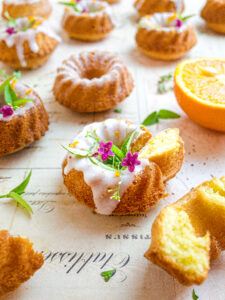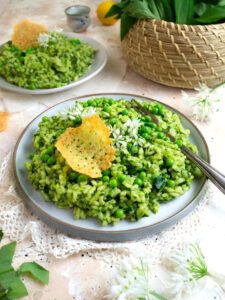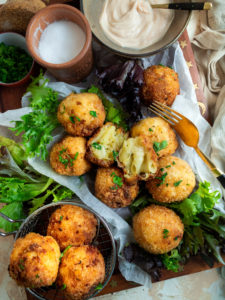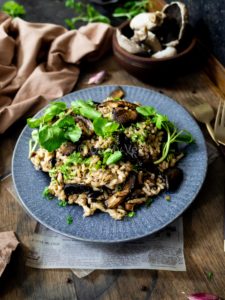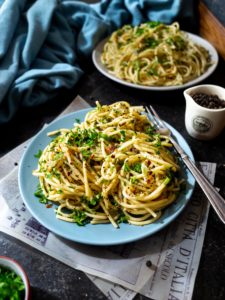Watercress Pesto Pasta with Mafaldine Noodles

Whenever I hear people saying that European foods lack flavor, I always do a double take! I adore highly spiced dishes like vegan lauki kofta or dal tadka as much as the next person — and learning to use spice is essential when you’re trying to master cooking — but sometimes simple foods and ingredients shine too. Perhaps the best example I can think of is pesto, which contains only a handful of ingredients yet boasts incredible flavor. Of course, the best thing about pesto is there are so many variations: basic basil pesto, foraged wild garlic pesto or dandelion pesto, and this watercress pesto pasta.
Watercress has a peppery, fresh flavor, making it a compelling choice for pesto as it adds a “heat” to the recipe and perfectly complements the fruitier notes from olive oil and zesty brightness of fresh lemon juice. I forgo the parmesan in traditional pesto (it’s not vegetarian) but choose to garnish my pasta with burrata instead, which melts into the dish, mellowing out the pesto with a creamy milkiness. It’s the epitome of simple, but so, so good.
For vegans, a nutritional yeast-pine nut mixture makes a tremendous parm alternative, or you could melt over Miyoko’s pourable plant mozzarella.
Like most Italian dishes, this watercress pesto pasta takes less than 30 minutes from start to finish, making it deal for busy days when you still want to impress. You’d even have time to pop up homemade garlic bread in the oven!
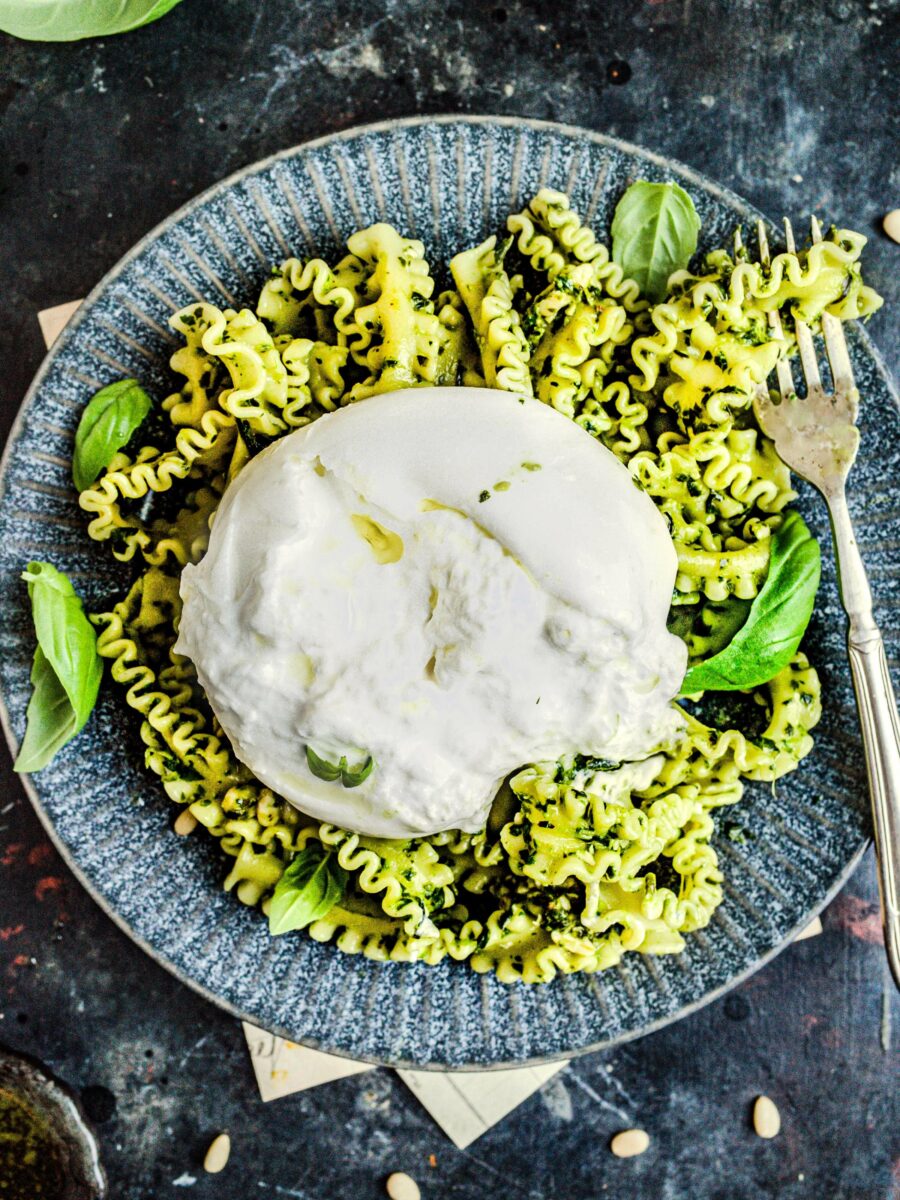
What is Mafaldine Pasta?
Mafaldine, also known as mafalda noodles, is a pasta variety distinguishable by long, wide noodles with ruffled edges. Its shape makes it perfect for embracing a variety of sauces, from the silky watercress pesto to the creamy mushroom sauce and even heartier ragù.
The pasta has a captivating and tragic history; it’s named Princess Mafalda of Savory (hence its other popular name, reginette or “little queens”). Princess Mafalda was beautiful and intelligent, although there isn’t much coverage about her early life.
The Princess married Prince Philip, Landgrave of Hesse, in 1925. He soon rose to the rank of officer in the National Socialist Party of Germany, later acting as an intermediary between Hitler and Mussolini. The Prince attempted to resign, but his sympathies towards the Jewish people — aiding many in escape — resulted in his fall from Hitler’s favor. He was sent to a concentration camp, where he remained until liberation.
Princess Mafada faced a harsher fate. A thorn in Hitler’s side, she actively opposed his war efforts. Tricked into visiting the German embassy, she was arrested and sent to a concentration camp. Her life ended tragically when Allied forces bombed a nearby ammunition center, mortally wounding her. The pair’s four children remained in Rome and survived.
Why the pasta is named for Princess Mafalda isn’t clear, although it could have been for her famously lacy dresses!
Mafaldine Pasta Substitute
While you can buy mafaldine pasta online or in most Italian sections of the grocery store, if you struggle to find the unique pasta or it’s out of your budget, don’t worry. There are a few acceptable substitutions!
Choose a similarly shaped long and wide ribbon-like pasta, such as pappardelle, tagliatelle, or fettuccine. Other thinner varieties such as spaghetti, bucatini, or linguine also work for this recipe!
Ingredients for Watercress Pesto Pasta
Like most of my other favorite Italian recipes (like vegan mushroom arancini or cavolo nero orecchiette with crispy breadcrumbs!), this watercress and basil pesto pasta has just a few ingredients.
Let’s check the ingredients you’ll need — this is the perfect opportunity to add any you need to your shopping list! You can find quantities in the recipe card below.
- Garlic is a must-add in any pesto recipe. Raw garlic is punchy and sharp, so we don’t use much — but it complements the other elements in this watercress pesto pasta.
- Watercress is bright and intensely peppery, perfect for making pesto. Grab some when the leafy green is in season for the best flavor!
- Olive oil has a grassy scent and taste, making it irreplaceable. Don’t try to substitute any other variety of oil, and be sure to use an excellent quality extra virgin olive oil (EVOO).
- Basil is pungent and slightly spicy, pairing well with the watercress.
- Pine nuts are mild, nutty, and buttery, adding a natural creaminess to the watercress pesto.
- Lemon juice isn’t a traditional pesto ingredient, but it makes the bright flavors of the watercress shine and adds a zesty undertone to the dish that makes it sing.
- Sea salt is vital for building up the other flavors.
- Mafaldine pasta, and long curly ribbons, are the perfect vessel for our vibrant watercress pesto to cling to.
- Burrata is an Italian cheese similar to mozzarella — except it has a creamy, soft interior. The cheese pairs well with the intense pesto flavors, helping to mellow it out and add a creamy texture. You can replace it with a vegetarian hard cheese or skip it to make the watercress pesto pasta vegan.
While this mafaldine pasta may have under ten ingredients and minimal seasoning, the flavor of the fresh ingredients like olive oil, watercress, basil, and fresh burrata cheese really shines. Trust me, it’s spectacular.
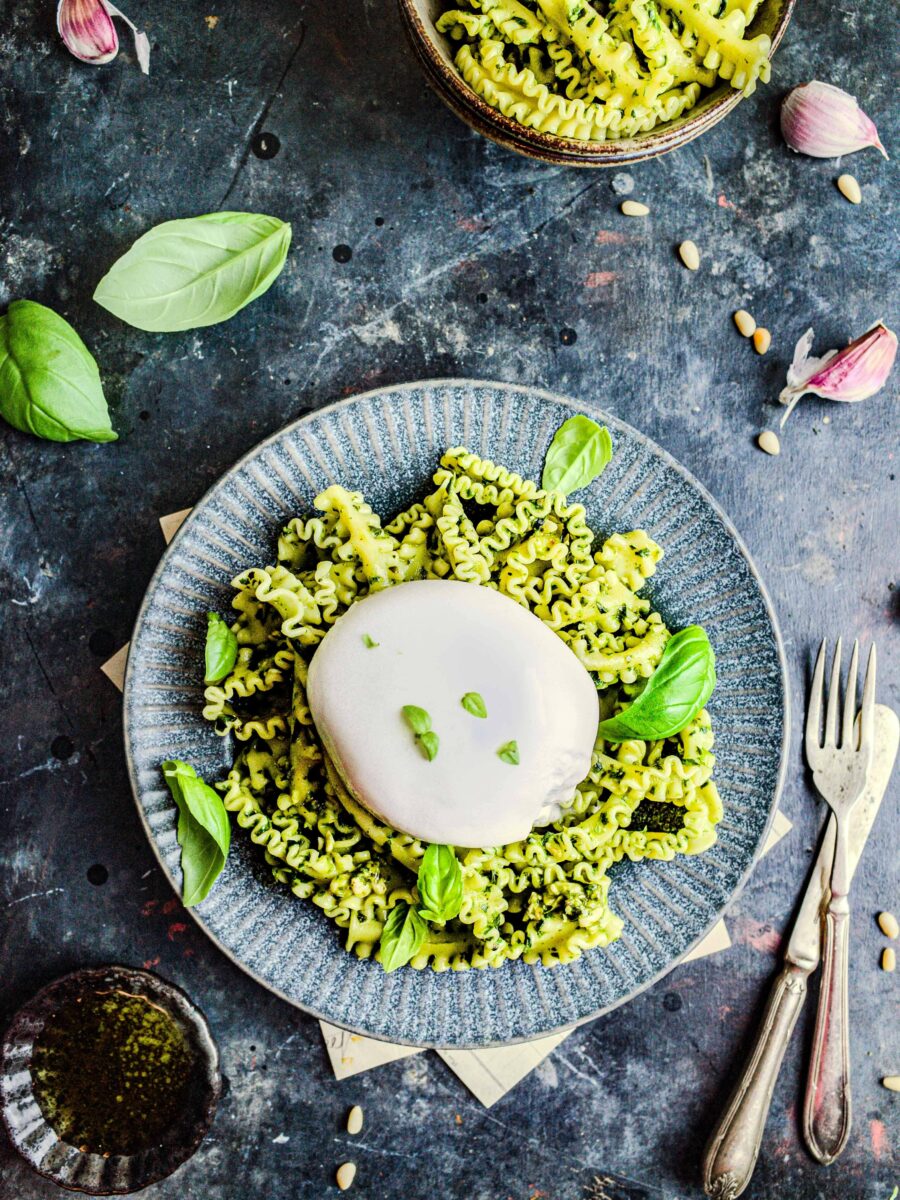
Can You Eat Wild Watercress?
No! Although I love foraging for food — you can make many delicious dishes, like my wild garlic and pea risotto or three-cornered leek soup — some ingredients are better bought commercially.
Watercress thrives abundantly in Britain, primarily in rivers and swamps. However, foraging wild watercress isn’t advisable due to safety concerns. The waterways where it grows remain unmonitored and may contaminate the plant with materials that pose health risks and could lead to severe illness.
As a result, experts highly suggest purchasing commercial watercress from your local grocery store or farmers market.
What Herbs Can You Put in Pesto?
You might be surprised to learn you can make pesto from almost any green herb or leafy vegetable!
While basil pesto is an Italian classic for a reason, I’m a big fan of switching it up. This recipe uses watercress and a handful of basil, but other leafy greens like mustard, spinach, kale, cavolo nero, dandelion greens, wild garlic, and rocket (arugula) work just as well.
You can also use herbs like parsley, oregano, coriander, sorrel, mint, or chives. Avoid woody herbs and, depending on the flavor, adjust how you use the pesto: as a sandwich spread, a salad dressing, or a pasta sauce, like this watercress pesto pasta.
I find that making pesto is an excellent way to use reduced greens from the supermarket or even salad that’s been in the fridge too long. Plus, if you forage for greens like wild garlic or dandelion, it’s the ideal way to preserve them.
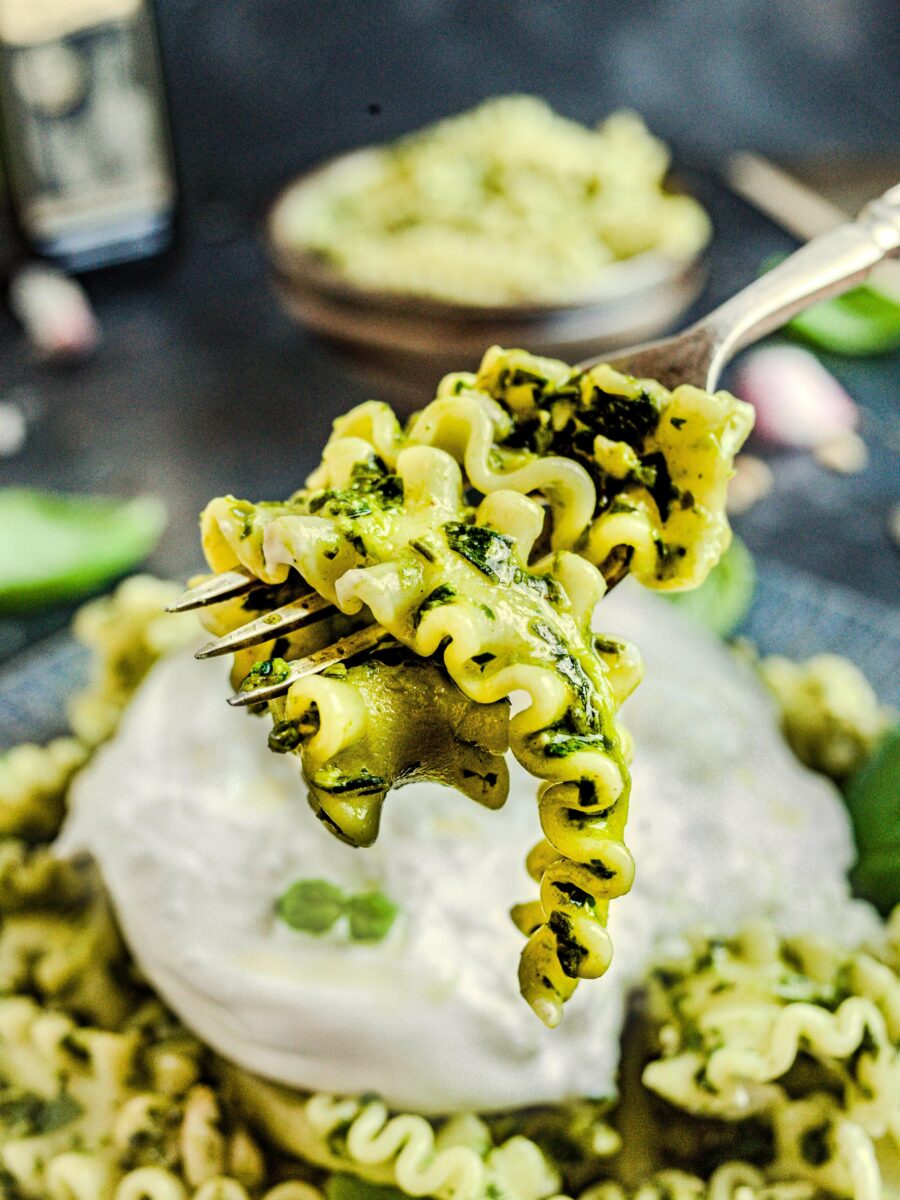
How to Make Pesto with Watercress
Skip the pesto from a jar. This watercress pesto isn’t just unique … it’s also easy peasy lemon squeezy to make at home. You only need a handful of ingredients and a simple technique.
I prefer to use a traditional mortar and pestle to make my pesto, but if you’re short on time or have limited mobility, a food processor will also work (and cut down the recipe prep time!)
- Crush the garlic and sea salt in a large mortar and pestle until you form a thick purée.
- Add the watercress and basil bit by bit. Crush them with circular motions in the mortar and pestle. Continue until they form a paste.
- Add the pine nuts to the mortar and pestle and crush them. The watercress pesto will appear lighter in color.
- Add the lemon juice and olive oil, then mix to combine. Check for seasoning.
To assemble the rest of the pasta, cook the mafaldine to package instructions and then drain. Toss the pasta with watercress and basil pesto, then serve with extra basil and a decent slice of burrata (optional).
Cookware You Need
Mortar and Pestle
food processor
Jar for pesto
This Recipe Is:

Watercress Pesto Pasta with Mafaldine Noodles
Make the most of fresh watercress by turning it into a delicious and easy vegetarian watercress pesto pasta topped with burrata.
Ingredients
For the Watercress Pesto
- 1 Garlic Clove
- 1/4 tsp Sea Salt
- 40g Watercress
- 5 tbsp Olive Oil
- 30g Fresh Basil
- 2 tbsp Pine Nuts
- 1 tbsp Lemon Juice (about 1/2 Lemon)
For the Pasta
- 250g Mafaldine Pasta
- Salted Water (to cook the pasta)
- 250g Burrata
Instructions
- Make the pesto. In a large mortar and pestle, crush the garlic and sea salt into a thick purée. Add the watercress and basil slowly, crushing with a circular motion. When they form a paste, add the pine nuts, until the pesto becomes lighter in color. Finally, add the lemon juice and olive oil. Mix to combine. Alternatively, you can throw all the ingredients in a food processor, or hand chop with a knife (following the same order as the mortar and pestle).
- Cook the pasta. Bring a large pot of salted water* to boil. Once it boils, add the pasta, and cook to package instructions.
- Drain the pasta and toss it with the pesto.
- Serve the mafaldine pasta in a pasta bowl or plate, and top with the burrata. Optionally, add a garnish of fresh basil or watercress.
Notes
* Pasta water should taste extremely salty, like sea water.
Recommended Products
As an Amazon Associate and member of other affiliate programs, I earn from qualifying purchases.
Nutrition Information:
Yield: 2 Serving Size: 1Amount Per Serving: Calories: 937Total Fat: 69gSaturated Fat: 22gTrans Fat: 0gUnsaturated Fat: 42gCholesterol: 99mgSodium: 1092mgCarbohydrates: 44gFiber: 3gSugar: 3gProtein: 37g
Nutrition information isn’t always accurate.







